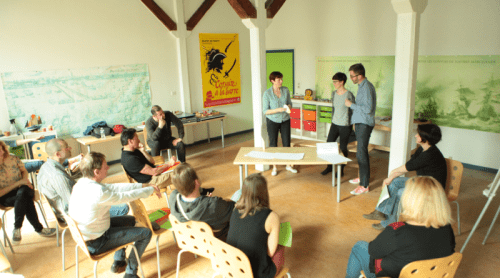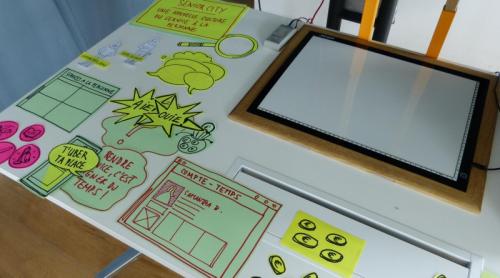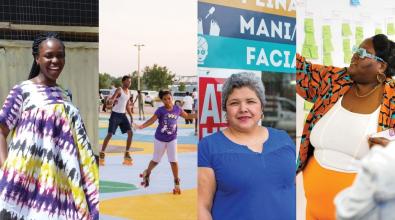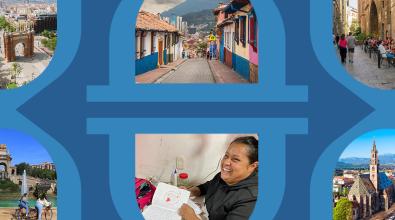5 lessons from a 4-year, 10-city innovation experiment in France
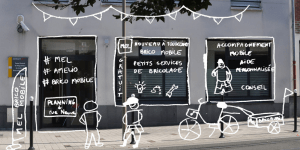
A reimagined vacant store front. (La 27e Région)
Responding to the COVID-19 pandemic demands that city leaders across the globe innovate like never before. That includes standing up new programs, from mobile testing to online permitting to expanding broadband internet, with remarkable speed and agility.
Now, as city leaders consider what is working well—and what isn't—many are urging cities not to lose the spirit of collaboration and urgency that generated these new ideas in the first place. If anything, innovation is needed now more than ever as local governments look to fix all the economic and social ills the pandemic laid bare.
“When you start looking at these complex social issues, you can't solve them by creating a single program,” said Stephanie Wade of Bloomberg Philanthropies. “These problems require multiple interventions on many levels. Principles that innovation gives us—like human-centered design and cross-sector collaboration—help us tackle these complex challenges comprehensively so we can not only improve the basic day-to-day city government operations but, more importantly, improve the lives of residents.”
In France, this spirit was alive both before and during the pandemic, through a program called “La Transfo.” The four-year project, an initiative of a Paris-based think tank called La 27e Région and supported by Bloomberg Philanthropies, aimed to embed a culture of experimentation and innovation in city halls. Through the program, 10 cities, including Paris, Mulhouse, and Dunkirk, built innovation labs made up of multi-disciplinary groups of residents, civil servants, and ambassadors from different city departments. These “i-teams” tested hundreds of innovative ideas in conjunction with city employees, elected officials, and residents.
As a result of this work, the French cities have—in every case—opted to make these labs permanent. To learn what lessons the La Transfo experience can offer city hall innovators everywhere, Bloomberg Cities caught up with Stéphane Vincent and Sylvine Bois-Choussy of La 27e Région.
Seeing is believing
La Transfo’s model trained civil servants in innovation skills over the course of 18 months, and those teams applied what they learned to challenges facing city residents. To be successful, innovation teams needed to build relationships and enthusiasm for their work by involving key stakeholders in city hall and the community in the early research, analysis, idea development, and testing phases of the process. This helped build cross-sector partnerships and buy-in around ideas.
For example, in 2018, the Occitanie region announced a “Green New Deal” that included recommendations from its innovation lab’s work on sustainable farming and food systems. The administration collected input from farmers, researchers, doctors, consumer groups, families, elected representatives, and city departments, and conducted a citizen survey to collect additional feedback. Among the results of that effort is a pilot project to create 14 “Farm Labs” in agricultural high schools to create spaces for exchange between key players in the food system, promote sustainable farming through research and technology, and foster a more entrepreneurial mindset in the sector. That project and several others from the innovation lab ultimately earned more than €1.1 million in regional and local funding.
Across the 10 La Transfo cities, this bottom-up method ultimately helped secure €8.5 million in public and private investments over four years.
Creating a culture of innovation means teaching, not telling
The adage rings true: “If you give a man a fish, you feed him for a day. If you teach a man to fish, you feed him for a lifetime.” La Transfo’s approach of training career civil servants allowed teams to develop their own experience with experimental methods that lead to innovation in their particular ecosystem. “It’s not just this series of projects,” Vincent said, “but also how do you create a culture of co-design [and] social innovation and encourage trial-and-error as a new way of designing policies?”
Placing ownership in the hands of city staffers helped sustain the innovation labs through administration changes. In every case, when the initiative ended, the lab was kept running with a team of one to 15 professionals and liaisons from city departments. So far, 32 full-time innovation positions have been created in La Transfo cities.
It takes a village
The La Transfo teams who provided training and support to cities were composed of three experienced professionals from different disciplines (for example, a designer, urbanist, and sociologist) who worked with and trained 20 civil servants from different city departments. This created a wide baseline of skills to rely upon when building the labs and experimenting with a variety of situations and policy ideas. Across the 10 cities, nearly 1,800 civil servants were trained in innovation methods and participated in 132 innovation sessions over the first 18 months of the project.
“Innovation isn’t a top-down process,” Bois-Choussy said. “You can’t just build it on a few cool and smart people who work in an office and produce excellent ideas. La Transfo demonstrated that innovation needs a variety of people...working together.”
Human-centered design cuts through the noise
Too often, new government programs are developed and funded without input from the people who are supposed to benefit from them. But a human-centered design approach engages users deeply from the earliest stages and all through development of the program, service, or policy. There’s no waiting until the idea is launched to get feedback—it comes constantly along the way. The root of the problem becomes a lot easier to find and money isn’t spent until all parties are confident in the design.
Over the past year of the pandemic, for example, Nantes created a mutual-aid program by asking residents what their basic needs were. The initiative matched requests for things like food delivery, student homework help, and face coverings, and matched them with volunteer or low-cost “offers” from other residents. The initiative helped meet the needs of more than 1,400 households.
Spending time with the people they’re helping also has a positive effect on public employee morale. “They’re changed through this kind of approach,” Vincent said. “Getting more feedback on what they do on a daily basis—there’s an impact on the whole organization.”
Innovation is contagious
Once these cities realize the impact a human-centered design approach can have, they want to start applying it widely across all their work. For example, Lille’s innovation team inspired the city’s suburbs to undertake about 300 innovation projects co-designed with residents. More broadly, the La Transfo model was shared or replicated publicly 40 times in France, and at least five public-sector innovation-lab efforts globally were directly inspired by La Transfo, including programs in Albania, Chile, and Serbia.
La 27e Région has also created a website called “Source Code” that any city can use as a blueprint for creating an innovation lab. Its resources include insights on potential opportunities and challenges, reference manuals, and sample work products that have so far been shared with over 350 people at workshops and presentations across Europe.
The hope, Vincent said, is that innovation labs become a lasting part of the local-government ecosystem. “It’s similar to how companies have built in the capacity to experiment through research and development [divisions],” he added. “Our vision is this could become the new normal in cities.”
